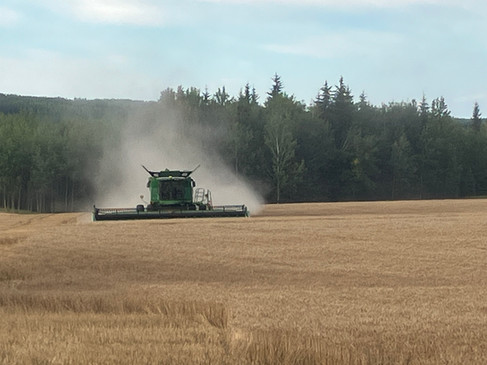Harvesting the Fruits of Our Regenerative Farm
- lifebreadwellness

- Sep 19
- 4 min read
Updated: Sep 22

Life Bread is an offshoot company of Tri-R Dairies Ltd. (grain only now), owned and operated by Otto & Melanie Rottier.

The wheat harvest is ready! Aug. 25th. LET’S ROLL!
Combining
Our first harvest operation is combining—the cutting of the stalks and the separation of grain seeds and chaff. We have 1 John Deere 770 combine (nothing runs like a Deer!) and 1 J.D. 9770 combine, each with a 35’ wide straight cut (no pre-swathing) J.D. Zurn header.
The rear of the combine houses a straw chopper. Its function is to cut the straw (wheat stalks) once separated from the seed heads into smaller pieces for better decomposition into the soil. De-composing fibres provides slow-release nutrients for plants. Straw boosts the biological activity by feeding microorganisms in the soil.
The hoppers, or grain tanks at the back and top of each combine (yellow tarp), are directly behind the operator's head, and hold 300- 400 bushels of wheat berries (900, 20lb wheat berry pails). Augers move the berries from the ground to the tanks.
The headers are connected to a computer system within the combine cabs that use the Guidance Positioning System (GPS). They are adjusted for height, and the GPS guides the header on an efficient, no-overlap path each time the combine turns to a new row and returns to the pre-set height automatically (autonomous steering). The beep in the video indicates the header's being controlled by the computer.

From the Combine to the Cart
Once the hoppers from the combines are full, they are emptied into a grain cart. When “labourers are few,” the grain is unloaded by the combine driver into the cart (holds 875 bushels), or if the terrain limits the grain cart’s access or safety, it sits idle.
Ideally, the combine hoppers are unloaded on the go to keep the combines moving during ideal conditions, which increases productive hours per day for best efficiency.
This galvanized steel (no rust) grain bin holds 10,000 bushels and has a hopper bottom (coneshaped) for easier unloading and aeration (external fans for cooling the grain).
The grain cart then transports its full load to either a B-train truck unit (holds 16,000 bushels), which gets unloaded later, or is driven directly to an elevator, if contracted by a grain buyer, or to a grain bin or a grain bag, for future storage. We practice both methods.
Storing the Wheat
Each of these bins requires aeration, as the wheat itself is not dried down to a certain percentage, 14.5% off the field, and is not free of green weed seeds. It exudes heat and moisture, increasing the chance for decreased seed quality and possible spoilage. Monitoring of these grain bins for the latter is done regularly (daily for a time).
These bins each have 7 internal temperature sensors, which respond to a compatible phone app, making the system quite accurate and quick-response friendly. The exhaust fan’s air flow blows through, up and out at quite a velocity. ”IT’LL KNOCK YOUR CAP OFF!”
Here is a more economical and shorter-term storage option: a bagging system. The heavy plastic bags range in diameter and length. This one is 10’W x 200’L and holds 10,000 bushels (= to our grain bins). The bagger itself has an auger (tractor propels it with its PTO) that pushes the grain into and down the bag as it enters from the top (grain cart spout discharge). The bagger’s wheels have brakes, which are needed for resistance which maintains pressure (750psi), so the bag fills with grain before it creeps forward. The tractor is kept in neutral and gets pushed along as the bag fills. Keeping the bag straight is up to the man on the ground, aligning the tractor with a target and watching its wheels to stay true.
The bag itself is stretched with the pressure of the grain and has to be monitored to prevent the bag from bulging, possibly splitting and crinkling, and by keeping the wheels moving at the right pace. Uniformity and consistency are essential for optimum storage (no oxygen spaces).
Once the grain is all loaded into the bag, the ends are folded and sealed.
AUG 29th! The wheat is in! The extra protective cover is used in the Athabasca region, with its many native animals (deer, elk, porcupines), to combat the significant damage to the bag caused by digging, trampling and poking the bags for their feasting. It is a thick protective mesh that is manually thrown over the bags, then secured with sand, dirt, tires or whatever works efficiently for each farmer. Bagging grain requires more manual labour and tenacity, especially in the winter months. It has advantages, too, as a bag can be located right where you are combining, reducing travel time and costs. It can also store higher moisture grain (wheat to 17-18%), decreasing wait time to get rolling!
Choices, decisions, intentions, priorities and values make up any successful and enjoyable operation. Especially one that knows the direction they are headed and can adjust to the forks in the road. We at TRI-R DAIRIES with LIFE BREAD are blessed!
The farmer knows what to do, for God has given him understanding… The Lord of Heaven’s Armies is a wonderful teacher and gives the farmer great wisdom. - Isaiah 28:26,29























